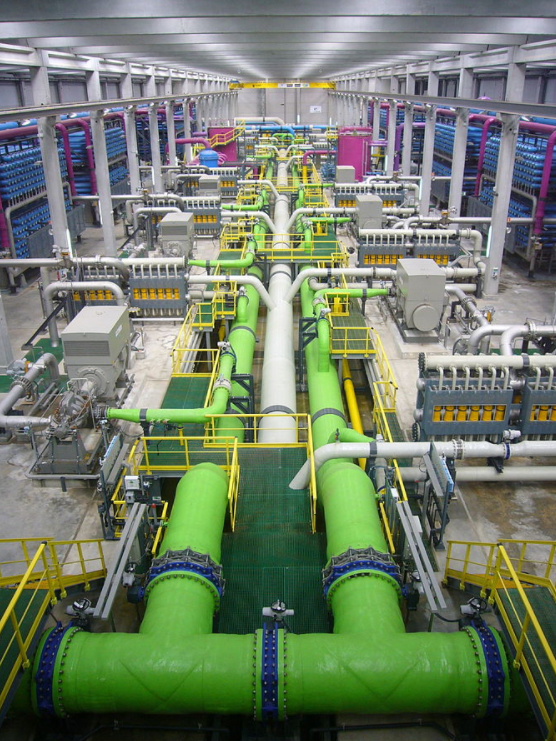
Clean freshwater is of the utmost importance for our health. Despite its central role for our lives, progressing global industrialization threatens freshwater resources around the world. Albeit a vital trace element, fluoride is a serious public health threat. Absorbed in larger quantities for a long time, fluoride causes fluorosis, a form permanent poising responsible for irreparable bone damage.
Fluoride bearing rocks are particularly common in India. Fluoride is leached into adjacent aquifers and contaminates the soil. Sometimes, the concentration of fluoride ions in Indian aquifers exceeds 30 mg/L. Toxic concentrations of 20-80 mg / day over a period of 10 to 20 years cause irreparable damage to the human body.
Fluoride ions in groundwater are removed for water treatment using membranes. However, such membranes foul easily, for example by bacteria present in wastewater or other deposits. Fouling can become a serious threat to public health. Therefore, a particular focus in membrane research is on the development of fluoride removing membranes that prevent fouling. It can be accomplished when bacterial growth is slowed down or inhibited entirely. For water treatment, antimicrobial surface modifications are used in high-quality membranes for ultrafiltration, nanofiltration, reverse osmosis and electrodialysis.
Electrodialysis is often used to remove water contamination, because only little energy is needed for the process. For electrodialysis membranes, salt deposits are an economic risk that is to be avoided. Precipitates can occur when the concentration of bivalent ions in the water is too high. Added to precipitates comes the risk of biofouling caused by microbial growth. Both affect the performance of electrodialysis membranes, causing economic losses as the membranes must be cleaned or replaced. For efficient water treatment, it is therefore important to improve the thermal and mechanical properties of the membranes.
A group of scientists have synthesized a composite anion exchange membrane for water-salt altitude and fluoride ion removal by electrodialysis that has improved antimicrobial properties. She published her results in the journal ACS ES&T Water. The consortium consisted of researchers of the Academy of Scientific and Innovative Research in Ghaziabad, India and the University of Tokyo.
Their anion exchange membranes are based on cross-linked terpolymers with built-in silver nanoparticles to slow microbial growth. The membranes are suitable for water desalination and fluoride ion removal by electrodialysis. The preparation of the terpolymers and polyacrylonitrile copolymers was carried out by N-alkylation using various alkyl halides. N-alkylation of the terpolymer through various alkyl groups affected the water absorption, hydrophobicity, ion transport and ionic conductivity of the membrane. Long alkyl groups increased the effectiveness of fluoride removal as well as the oxidative and physical stability of the membranes. The suitability of the composite membranes was verified by testing removal efficiency of fluoride ions (5.5 and 11 mg/L) from a sodium chloride solution (2 g/L) by electrodialysis at an applied voltage of 2 V.
The incorporation of 0.03% silver nanoparticles in the quaternized polymer caused the desired antimicrobial effect. The uniform distribution of silver nanoparticles in the liquid and solid phases was detected by transmission electron microscopy and atomic force microscopy. The attachment of bacteria was quantified counting colony forming units and 100x lower when silver nanoparticles were present in the membrane. The reduced microbial attachment to the membrane surface is therefore due to the antimicrobial effect of the silver nanoparticles. The small amount of 0.03% silver nanoparticles was sufficient to achieve desired antimicrobial effect in the membrane.
After 15 days and at a water temperature of 50°C, no detectable silver leaching occurred. The novel membranes are thus an improved anion exchange solution with antimicrobial properties for efficient removal of fluorine and desalination by electrodialysis.
Methodology
The entire synthesis was carried out in four steps:
- Step 1: Silver nitrate was diluted with deionized water to produce a 30 mm solution
- Step 2: Terpolymer and quaternized terpolymers were prepared by free radical polymerization
- Step 3: Composite additives were prepared by the reduction of silver nitrate with sodium borohydrite in the presence of dimethylformamide
- Step 4: The membrane was networked with the silver nanoparticles
Characterization of the anion exchange membrane
The membrane was characterized using several analytical methods:
- UV-VIS and IR spectroscopy
- Incorporation of silver nanoparticles by scanning electron microscopy, atomic force microscopy and transmission electron microscopy
- Thermal stability, tensile properties, solubility and further physicochemical and electrochemical properties of the silver nanoparticle composite
- Desalination and fluoride removal
- The effectiveness of silver nanoparticles on microbial attachment
- Energy consumption and efficiency during water desalination and fluoride removal by the composite membrane
- Membrane stability with respect to pH, temperature and Fenton’s Reagent was evaluated
Reference:
Pal et al. 2021 “Composite Anion Exchange Membranes with Antibacterial Properties for Desalination and Fluoride Ion Removal” ACS ES&T Water 1 (10), 2206-2216, https://doi.org/10.1021/acsestwater.1c00147
Image: Wikipedia




